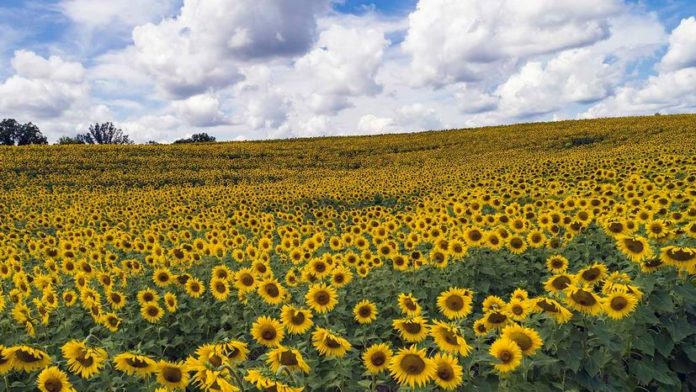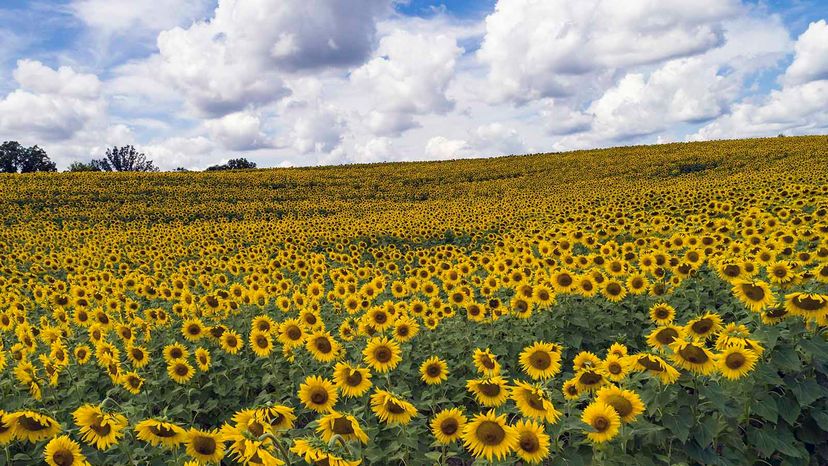 “Not many things look more glorious than a field of blooming sunflowers. Photograph by Tudor ApMadoc/Getty Images
“Not many things look more glorious than a field of blooming sunflowers. Photograph by Tudor ApMadoc/Getty Images
One of the top reasons sunflowers are so special has to do with their bright and cherry appearance. Just looking at them will instantly lift your mood.
"Sunflowers make people happy," Raleigh Wasser, horticulture manager for the Atlanta Botanical Garden says via an email interview. "It might be the bright petals around the central face that is so attractive to people."
Resembling the sun, those vibrant yellow petals (also known as "rays") indeed make these "happy flowers" the perfect gift to bring joy to someone’s day. But there is much more to these cheery flowers than meets the eye. Here are 10 reasons these stunners are not only extremely popular, but also quite extraordinary.
1. There are So Many Varieties
More than 70 cultivars of Helianthus exist, with the common sunflower species being Helianthus annuus — Helianthus meaning helios (or sun)and anthus (flower), according to Wasser. "Within all of these species are an abundance of different colors and forms, ranging from small to very large, from having yellow petals to red," he says. "Extensive crossing and hybridizing have resulted in a large number of cultivars that greatly expand the range of flower colors (ray flowers in bright and pastel shades of yellow, red, mahogany, bronze, white and bi-colors) and flower head shapes (short rays, long rays, some doubles).
"There are dwarf varieties (1 to 3 inches [2.5 to 7.6 centimeters] tall) and mammoth varieties (up to 15 feet [4.5 meters] tall)," he adds. "The flower heads on mammoth varieties can reach 12 inches [30 centimeters] in diameter. Disk flowers give way to the familiar sunflower seeds."
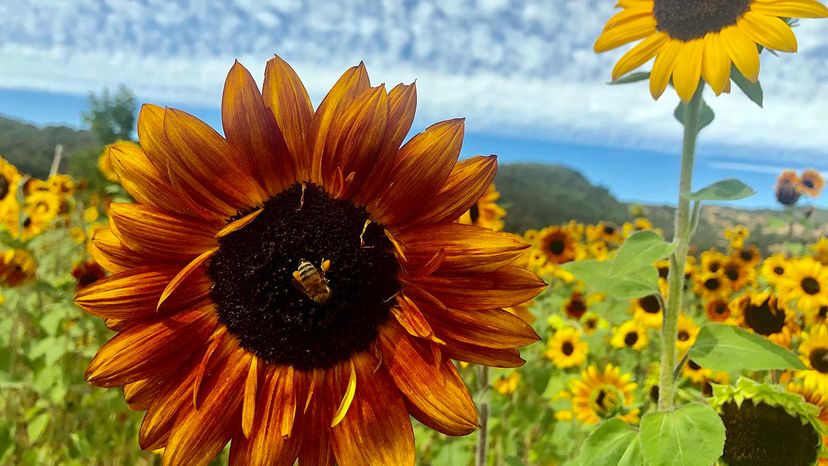 “Sunflowers bloom in an abundance of different colors, including yellow, red, mahogany, bronze and even white.Geri Lavrov/Getty Images
“Sunflowers bloom in an abundance of different colors, including yellow, red, mahogany, bronze and even white.Geri Lavrov/Getty Images
2. They’re Easy to Grow
In fact, sunflowers are so easy to grow, Wasser says that they sometimes sprout up under bird feeders that have simply dropped seeds. But in general, he adds, if you want to plant them, you should sow the seed directly into the soil after the danger of frost has passed in spring. You can also start the seeds indoors and transplant them.
Perennial sunflowers of the Helianthus genus (as opposed to annuals) can be planted in spring or fall. Seeds should sprout in seven to 10 days, and depending on the variety, sunflowers will bloom after a couple of months based on growing conditions, with the flower maturing and developing seeds in 80 to 120 days.
"You don’t need to use fertilizer for most garden soils," Wasser says. "Even if your soil is very poor, you won’t need more than a light application of slow-release granular fertilizer. The flowers are drought tolerant and do fine with an occasional watering in the driest weather."
Note: Sunflowers might need staking when they’re younger and haven’t developed a strong root system, especially if they are tall and developing a heavy head. Make sure the roots have adequate space and loose enough soil to spread.
 “The rays of sunflowers can grow to be enormous, and some varieties of the flower can grow up to 15 feet tall. Henglein and Steets/Getty Images/Cultura RF
“The rays of sunflowers can grow to be enormous, and some varieties of the flower can grow up to 15 feet tall. Henglein and Steets/Getty Images/Cultura RF
3. It’s Difficult to Extend the Life of the Rays
Unfortunately, once a sunflower is in the ground and blooming, there’s not much you can do to keep those rays. "If the variety has many stems, the grower can deadhead spent flowers to redirect growth to the remaining buds," says Wasser. If you want to cut the flowers, though, and put them in a vase, Wasser suggests changing out the water out every two to three days. When you do freshen the water, cut the base of the stems at a 45-degree angle (do this while they’re under warm running water). And keep the cut flowers away from direct light and from high humidity.
4. Sunflowers Need Lots of Sun
Ideally, sunflowers should get full sun for at least eight hours a day, Wasser says. "If their requirement for plenty of direct sun is met," he says, "they will reward you with long-lasting blooms throughout summer and sometimes into fall." While sun is the most essential ingredient, however, taller sunflower varieties — like ‘Sunzilla,’ which grows up to 16 feet (4.8 meters) tall — also need protection from wind, he adds.
5. They Can Track the Sun
Immature flower buds of the sunflower exhibit solar tracking, and on sunny days, the buds will follow the sun across the sky from east to west. By dawn, the buds will have returned to face eastward. However, as the flower bud matures and blossoms, the stem stiffens and the flower becomes fixed facing the east. Flowers of the wild sunflowers seen on roadsides do not follow the sun, and their flowering heads face many directions when mature. The leaves do exhibit some solar tracking.
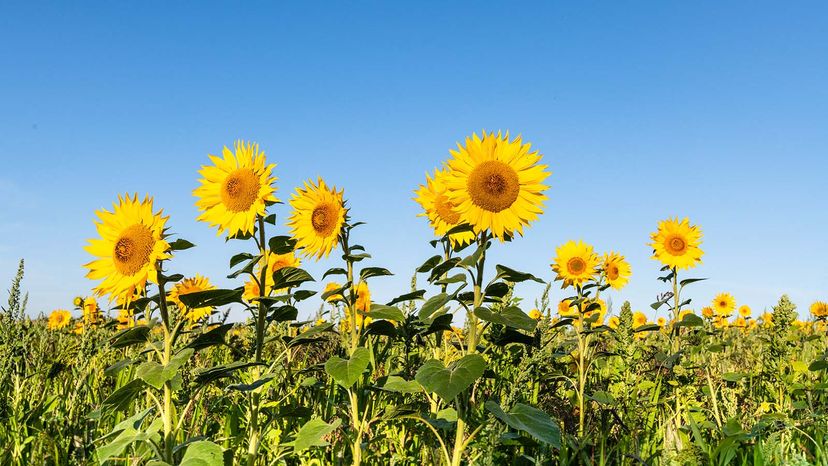 “On sunny days, the buds of sunflowers will actually track the sun across the sky from east to west.Mike Powles/Getty Images
“On sunny days, the buds of sunflowers will actually track the sun across the sky from east to west.Mike Powles/Getty Images
6. Greek Mythology Tells Why Sunflowers Face the Sun
In Greek mythology, the story of the nymph Clytie and Helios (the sun god) is one of love and betrayal. Clytie loves Helios and at first, he loves her too. But soon he betrays Clytie and falls in love with Leucothea, daughter of Orchamus. Because of her jealousy, Clytie tells Leucothea’s father of the relationship. Helios is only angered by her decision and he punishes her by burying her alive. Clytie, though, still loves Helios and lays naked for nine days staring at the sun, without food or water. On the ninth day, she becomes a flower — the heliotrope or sunflower — and turns toward the sun.
7. Sunflowers Are an Important Food Source
Originally cultivated by North American Indians in present-day Arizona and New Mexico around 3000 B.C.E., the sunflower has a long and interesting history as a food plant. Some archaeologists suggest that sunflower may have been domesticated before corn.
The various American Indian tribes used the sunflower in many ways: Seed was ground or pounded into flour for cakes, mush or bread; some tribes mixed the meal with other vegetables, such as beans, squash and corn; and the seed was cracked and eaten for a snack. There also are references that they squeezed the oil from the seed and used it to make bread.
8. One Sunflower Produces Around 1,000 Seeds
Each sunflower head can contain as many as 1,000 to 2,000 seeds. Each seed can be quite different when it comes to appearance, but the most common kind used for snacking has a black and white striped pattern on the hull. Other types of seeds (such as the white or black sunflower seeds) are fully edible, but are typically used for other purposes, such as for sunflower oil.
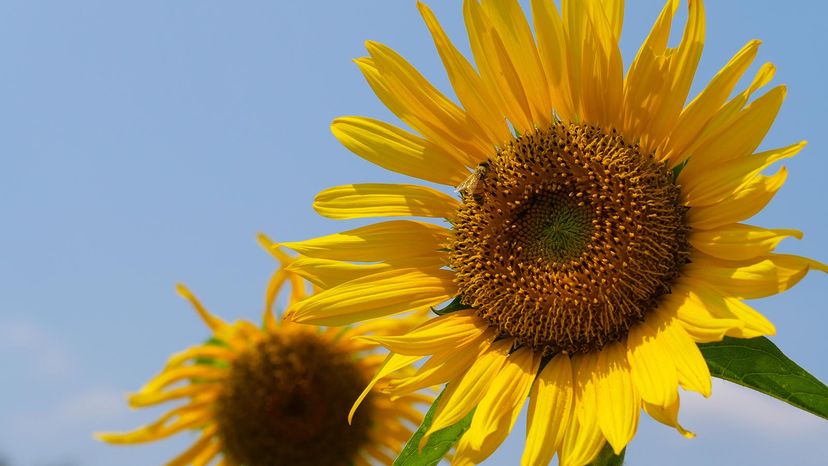 “The huge heads of sunflowers are also known as ‘rays’ because they look like the sun.kazue tanaka/Getty Images
“The huge heads of sunflowers are also known as ‘rays’ because they look like the sun.kazue tanaka/Getty Images
9. You Can Harvest Sunflower Seeds
For edible sunflowers seeds, you need to grow the annual variety (Helianthus annuus), says Wasser. "You must harvest the flowers after the leaves shrivel, but before the seasonal rains," he says. "The flower heads (including 1 to 2 feet [30 to 60 centimeters] of stalk) must spend another month hanging in a dry, well-aired spot before you extract the seeds." Once you’ve done that, you try your hand at roasting them.
10. You Also Can Make Sunflower Oil
Your own homemade sunflower oil can have multiple purposes, including cooking or for beauty products. This recipe requires 35 pounds (15.8 kilograms) of oilseeds, though you’ll net 3 gallons (11.3 liters) of oil. That means if you’re growing your own sunflowers, you’d need the seeds of about 140 plants!
NOW THAT’S INTERESTING
Vincent van Gogh’s sunflower paintings opened the door to a new evolution in decor and art. "Not only did van Gogh inspire others to paint sunflowers, but he also created a trend that would span various lifestyles and personas," according to the Van Gogh Gallery, the definitive reference for information about the artist’s life and work. "His infamous sunflowers altered many views on color schemes, exaggerated features and stereotypically beautiful flowers in minimalistic form."





























